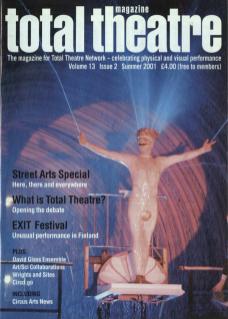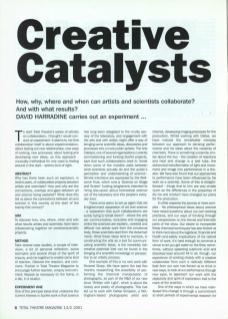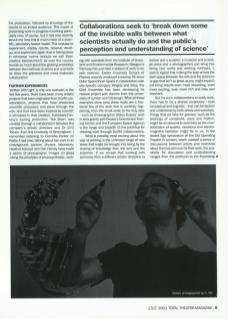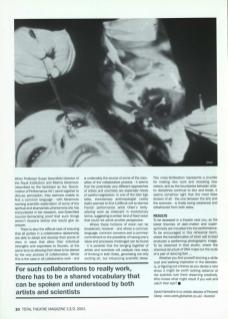To start Total Theatre's series of articles on collaboration, I thought I would conduct an experiment. It seems to me that collaboration itself is about experimentation, about testing out new relationships, new ways of working, new processes; about testing and developing new ideas, so this approach – unusually methodical for one used to feeling around in the dark – seems kind of right.
Abstract
Why has there been such an explosion, in recent years, of collaborative projects between artists and scientists? How and why are the connections, overlaps and gaps between art and science being explored? What does this tell us about the connections between art and science in this country at the start of the twenty-first century?
Aim
To discover how, why, where, when and with what results artists and scientists have been collaborating together on creative/scientific projects.
Method
Take several case studies, a couple of interviews, a bit of personal reflection, some examples and several drops of the spirit of enquiry, and mix together to enable some kind of reaction. Observe the reaction, and comment. Publish in Total Theatre Magazine to encourage further reaction, enquiry and comment. Repeat as necessary (in the home, in a lab, in a studio).
Experiment One
One of the principal ideas that underpins the current interest in Sci/Art work is that science has long been relegated to the murky secrecy of the laboratory, and engagement with the arts and with artists might offer a way of bringing some scientific ideas, discoveries and processes into a more public sphere. The Arts Catalyst, one of several organisations currently commissioning and funding Sci/Art projects, says that such collaborations seek to 'break down some of the invisible walls between what scientists actually do and the public's perception and understanding of science'. Similar intentions are expressed by the Wellcome Trust, which runs a 'Science on Stage and Screen' funding programme intended to 'bring discussion about biomedical science out of the laboratory and into people's everyday lives'.
These aims seem to set up again that old Enlightenment separation of art and science – a separation that such collaborations are surely trying to break down? – where the arts are communicative, evocative and engaging whilst the sciences are esoteric, cerebral and difficult (we artists work from the emotional body, those scientists start from the detached mind). What these ideas tend to overlook, in constructing the arts as a tool for communicating scientific ideas, is the incredibly rich creative potential that can be found in the bringing of a scientific knowledge or perspective to an artistic process.
One example of this is my own work with Fevered Sleep. We have spent the last few months researching the possibility of performing the chemical manipulation of photographs, as part of the R&D of our new show Written with Light, which is about the history and poetry of photographs. This has led us to work with Dallas Simpson, a Nottingham-based photographic artist and chemist, developing imaging processes for the production. Whilst working with Dallas, we have noticed the remarkable interplay between our approach to devising performance and his ideas about the creativity of chemistry. There is something uncannily similar about the two – the creation of reactions and heat and change in a test tube, the alchemical transformation of light and movement and image into performance in a theatre. We have also found that our approaches to performance have been influenced by his work as a scientist. Some of this is straightforward – things that to him are very simple (such as the differences in the properties of dry ice and smoke!) have changed our plans for the production.
For such collaborations to really work, there has to be a shared vocabulary that can be spoken and understood by both artists and scientists
In other respects the journey is more complex – his philosophical ideas about science have raised questions about our own working practices, and our ways of thinking through our perspectives on the formal and thematic parts of the show. Our desire to incorporate these chemical techniques has also forced us to think hard about the logistical, financial and health-and-safety implications of his radical form of work; it's hard enough to convince a venue to let you get water on the floor, sometimes, without splashing sulphuric acid and dissolved lead around! All in all, though, our experience of working closely with a creative collaborator from such a radically different field from our own has forced us to think in new ways, to look at our performance through new eyes, to approach our work with the objectivity and spirit of exploration that is the mark of the scientist.
One of the ways in which we have manifested this change is through a commitment to short periods of experimental research for the production, followed by showings of the results to an invited audience. This model of presenting work-in-progress is nothing particularly new, of course, but it has only recently struck me how this is much more of a scientific, laboratory-based model. This impulse to experiment, display results, observe, develop, and experiment again that is taking place in rehearsal rooms (should we call them creative laboratories?) all over the country reveals as much about the growing similarities between the methods of artists and scientists as does the grandest and most elaborate collaboration.
Further Experiments
Written with Light is only one example; in the last few years, there have been many artistic projects that have originated from Sci/Art collaborations, projects that have presented scientific processes and ideas through the arts, and that have been inspired by scientific principles in their creation. Forkbeard Fantasy's touring production The Brain was created through a collaboration between the company's artistic directors and Dr Emil Toescu from the University of Birmingham; I remember listening to Cornelia Parker on Radio 4 last year, talking about her work in an underground particle physics laboratory; Heather Ackroyd and Dan Harvey have made a series of photographic images on grass (using the principles of photosynthesis), working with scientists from the Institute of Grassland and Environmental Research; Glasgow's Tramway has just held a season of work to do with science; Exeter University School of Physics recently produced a touring TIE show Outer Space/Inner Space in collaboration with site-specific company Wrights and Sites; the Clod Ensemble has been developing its newest project with doctors from the universities of London and Edinburgh. What all these examples show (and these really are a fractional few of the work that is currently happening, from the small-scale to the truly epic – such as choreographer Kitsou Dubois' work in zero gravity with Russia's Cosmonaut Training Centre and the European Space Agency) is the range and breadth of the potential for creating work through Sci/Art collaborations.
What is possibly most exciting about this way of working is the unlimited range of new ideas that might be brought into being by the sharing of knowledge from the arts and the sciences. If we accept that working with someone from a different artistic discipline (a dancer and a sculptor, a musician and a cook; an actor and a photographer) can bring into being new works and working methods, it seems logical that making the leap across the dark space between the arts and the sciences (a gap that isn't so great as you might expect) will bring results even more rewarding, even more exciting, even more rich and risky and resonant.
But for such collaborations to really work, there has to be a shared vocabulary – both conceptual and linguistic – that can be spoken and understood by both artists and scientists. Things that we take for granted, such as the workings of complicité, pace and rhythm, might be as obscure to scientists as the characteristics of quarks, neutrinos and electromagnetic radiation might be to us. In the recent Ego symposium at the Old Operating Theatre in London, which curated a series of discussions between artists and scientists about themes common to their work, the possibility for discussion and understanding ranged from the profound to the frustrating.
When Professor Susan Greenfield (director of the Royal Institute) and Marina Abramovic (described by the facilitator as the 'Grandmother of Performance Art') came together to discuss perception, they seemed unable to find a common language – with Abramovic wanting scientific explanation of some of the spiritual and shamanistic phenomena she has encountered in her research, and Greenfield counter-demanding proof that such things weren't illusions before she would give an answer.
There is also the difficult task of ensuring that all parties in a collaborative relationship are able to adapt and develop their points of view, in ways that allow their individual strengths and expertises to flourish, at the same time as allowing their ideas to be altered by the very process of collaboration. Whilst this is the case in all collaborative work – and is undeniably the source of some of the casualties of the collaborative process – it seems that the potentially very different approaches of artists and scientists are especially needy of careful negotiation. In one of the later Ego talks, evolutionary anthropologist Lesley Aiello seemed to find it difficult not to dismiss French performance artist Orlan's body-altering work as irrelevant in evolutionary terms, suggesting a certain kind of fixed vision that could not admit another perspective.
Where these horizons of vision can be broadened, however – and where a common language, common concerns and a common commitment to the possibility of having one's ideas and processes challenged can be found – it is possible that the bringing together of artists and scientists will catalyse new ways of thinking in both fields, generating not only exciting art, but influencing scientific ideas.
This cross-fertilisation represents a crucible for making new work and revealing new visions, and as the boundaries between artistic disciplines continue to blur and break, it seems somehow right that the most false division of all – the one between the arts and the sciences – is finally being weakened and refashioned from both sides.
Results
To be assessed in a theatre near you, as the latest theories of dark-matter and supersymmetry are moulded into live performance. To be encouraged in this rehearsal room, where the transformation of silver salt to lead produces a performing photographic image. To be observed in that studio, where the chemical structure of DNA maps out the route of a pair of dancing feet...
Whether you find yourself donning a white coat and seeking inspiration in the laboratory, or figuring out a theory as you devise a new show, it might be worth looking askance at the scientist over there dreaming creatively. Who knows what might result if you wait and catch their eye?



